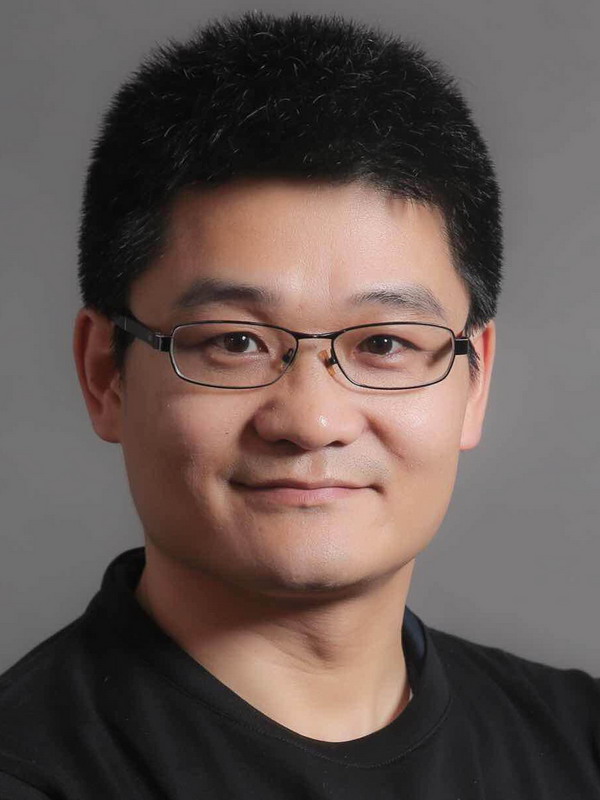
**长期招聘博士后,从事CV/PR/ML相关方向,欢迎联络**
Shiguang Shan received M.S. degree in computer science from the Harbin Institute of Technology, Harbin, China, in 1999, and Ph.D. degree in computer science from the Institute of Computing Technology (ICT), Chinese Academy of Sciences (CAS), Beijing, China, in 2004. He joined ICT, CAS in 2002 and became a full Professor in 2010. He is now the director of the Key Lab of Intelligent Information Processing of CAS.
His research interests cover computer vision, pattern recognition, and machine learning. He especially focuses on computational face perception related research topics, and machine learning with data of limited supervision. He has published more than 300 papers in refereed journals and proceedings. He has served as Area Chair (or Senior PC) for many international conferences including CVPR19/20/21/22, AAAI20/21/22, IJCAI21, ICPR12/14/20, ACCV12/16/18, FG13/18/20, BTAS18, ICASSP14, and ICCV11. He is(/was) Associate Editors of several international journals including IEEE Trans. on Image Processing, Computer Vision and Image Understanding, Neurocomputing, and Pattern Recognition Letters. He is a recipient of the China’s State Natural Science Award in 2015, and the China’s State S&T Progress Award in 2005 for his research work.
He is also the co-founder and rotating Chairman of Steering Committee of VALSE (Vision And Learning SEminar), a China-based non-official scholarly community. VALSE holds annual conference every year since 2011, and has held more than 220 times of Webinar (online seminar) since 2014. Numerous Chinese researchers and students have benefitted from these VALSE events. Taking VALSE Annual Conference 2019 as an example, more than 5,000 audiences attended this event held in Hefei China.
He is also personally interested in brain science, cognitive neuroscience, as well as their interdisciplinary researche topics with AI.
My ORCID: https://orcid.org/0000-0002-8348-392X
My Google scholar: https://scholar.google.com/citations?user=Vkzd7MIAAAAJ
山世光,中科院计算所研究员、博导,现任中科院智能信息处理重点实验室主任。他的研究领域为计算机视觉和机器学习。已在国内外刊物和学术会议上发表论文300余篇,其中CCF A类论文100余篇,论文被谷歌学术引用25,000余次。所研发的人脸识别相关研究成果获2005年度国家科技进步二等奖,在高维、非线性视觉模式分析方面的研究成果获2015年度国家自然科学二等奖。他带领团队研发的人脸识别技术已应用于公安部门、华为等众多产品或系统中,取得了良好的经济和社会效益。曾应邀担任过ICCV11,ACCV12/16/18,ICPR12/14/20,FG13/18/20,ICASSP14,BTAS18, AAAI20/21/22, IJCAI21, CVPR19/20/21/22等十余次领域主流国际会议的领域主席,现/曾任IEEE TIP, CVIU, PRL, Neurocomputing, FCS等国际学术刊物的编委(AE)。他是基金委优青,国家重要人才计划入选者,科技部创新人才推进计划中青年科技创新领军人才,人社部国家百千万人才工程有突出贡献中青年专家,CCF青年科学家奖获得者,北京市科技新星,中科院青促会优秀会员。
他的研究兴趣集中于以人脸识别为典型案例的计算机视觉和机器学习理论、方法和关键技术上,特别是在人脸识别领域有超过20年的研究经验。近年来开始重点关注基于视觉的深度情感计算,如远距离、无接触生理信号估计,心理状态估计,精神状态评估等。在理论和算法层面,他和团队有非常丰富的机器学习特别是深度学习研究经验,尤其关注X数据条件下深度结合“知识”的机器学习理论和方法,这里所谓的X数据包括小数据、无监督数据、半监督数据、弱监督数据、脏数据、增广数据等等。
他是视觉与学习青年研讨会(VALSE)的共同发起人,VALSE指导委员会轮值主席。作为一个计算机视觉与机器学习领域的学术共同体,VALSE自2011年发起以来,每年举办规模十分可观的学术年会,其中VALSE2019(合肥)参加人数超过了5000人。同时,自2014年9月以来,VALSE定期举办在线学术报告会(VALSE Webinar),每次参加人数300~2500人不等。VALSE已成为中国计算机视觉领域影响力最大的学术社群。
作为个人兴趣,他深切关注认知神经科学和脑科学的进展,并乐于思考和讨论生物视觉的本质问题,以及脑神经科学给视觉计算带来的启示。
刊物服务
[1] Associate Editor of Frontier of Computer Science (2018-)
[2] Associate Editor of IEEE Trans. on Image Processing (2015-2018)
[3] Associate Editor of Journal of Computer Vision and Image Understanding (2017-)
[4] Associate Editor of Pattern Recognition Letters (2017-)
[5] Associate Editor of Neurocomputing (2012-2016)
[6] Editor Board member of EURASIP Journal of Image and Video Processing
[7] Associate Editor of IPSJ Transactions on Computer Vision and Applications (CVA)
[8] Associate Editor of IET Computer Vision (2020-)
会议服务
[1] General Co-chair of IEEE Conference on Face and Gesture Recognition 2023 (FG2023)
[2] General Co-chair of Asian Conference on Computer Vision (ACCV) 2022
[3] Area Chair of the 36th AAAI Conference on Artificial Intelligence (AAAI2022)
[4] Area Chair of the 30th International Joint Conference on Artificial Intelligence (IJCAI-21)
[5] Area Chair of the 35th AAAI Conference on Artificial Intelligence (AAAI2021)
[6] Area Chair of IEEE/CVF Conference on Computer Vision and Pattern Recognition 2021
[7] Area Chair of IEEE Conference on Face and Gesture Recognition 2020 (FG2020)
[8] Senior PC of the 34th AAAI Conference on Artificial Intelligence (AAAI-20)
[9] Area Chair of IEEE/CVF Conference on Computer Vision and Pattern Recognition 2020
[10] Area Chair of IEEE/CVF Conference on Computer Vision and Pattern Recognition 2019
[11] Area Chair of IEEE International Conference on Biometrics: Theory, Application AND Systems (BTAS 2018)
[12] Area Chair of IEEE International Conference on Automatic Face and Gesture Recognition (FG 2018)
[13] Area Chair of Asian Conference on Computer Vision (ACCV) 2018
[14] Area Chair of International Conference on Computer Vision (ICCV) 2011
[15] Program Chair of Chinese Conference on Biometric Recognition 2014, 2015, 2016
[16] Area Chair of International Conference on Pattern Recognition (ICPR) 2012
[17] Area Chair of Asian Conference on Computer Vision (ACCV) 2012
[18] Area Chair of International Conference on Face and Gesture Recognition (FG2013)
[19] Workshop Chair of Asian Conference on Computer Vision (ACCV) 2014
[20] Area Chair of Asian Conference on Computer Vision (ACCV) 2016
[21] Area Chair of International Conference on Pattern Recognition (ICPR) 2014
1. Machine learning: deep learning and beyond
重点关注复杂数据条件下的机器学习方法和技术,特别是面向小规模、弱标注、半监督、非完备、非纯净等数据条件下的机器学习方法,研究思路包括自监督学习、迁移学习、元学习、知识引导的学习算法等。
My team focuses on new machine learning methods for scenarios with complex data conditions, especially small data, wealy-labeled data, semi-supervised data, incomplete data, where new models and new optimizing methodsareneeded to design. In terms of methodology, I am interested in self-supervised learning, transfer learning, meta-learning, and knowledge-guided learning.
2. From face recognition to deep human understanding: methods, technologies, and applications
从事人脸检测与跟踪、面部关键特征点定位、人脸识别与验证、表情分析与识别、人脸属性估计、唇语识别、心率估计、专注度估计、视线估计与跟踪等与人脸感知和深度理解计算相关的研究课题。应用合作单位包括:华为、平安、百度、银晨科技、三星、欧姆龙、松下、高通、中移动等,2016年和2017年两次获华为优秀合作成果奖。相关成果还曾获2015年度国家自然科学二等奖等,2005年度国家科技进步二等奖。
My team is interested in all kinds of vision tasks from face recognition to human understanding, including (but not limited to) face detection and tracking, facial landmark locating, face alignment, face identification, face verification, face retrieval, expression recognition, facial attribute estimation, 3D face reconstruction, face parsing, lip reading, heart rate estimation, engagement estimation, gaze tracking, etc. We have broad cooperation with industrial parters, including Huawei, Ping'an, Qualcomm, China Mobile, Baidu, Isvision, Samsung, Omron, Panasonic, etc. Especially, our face recognition technology has been used on Huawei smart phone and Huawei Cloud album.
3. Generic object detection, segmentation, and recognition
关注通用目标检测、分割和识别等计算机视觉任务,重点关注面向视频监控场景的行人检测与跟踪、人体姿态估计与分割、车辆检测与跟踪、行人再识别和车辆再识别等研究课题。
My team is also interested in generic object detection, segmentation, and recognition, especially pedestrian detection and tracking, human pose estimation and body segmentation, vehicle detection and tracking, human and vehicle re-identification etc. These technologies are applied to video surveillance.
1. Please kindly refer to my Google scholar homepage: https://scholar.google.com/citations?user=Vkzd7MIAAAAJ&hl=zh-CN